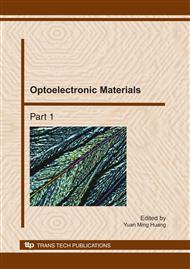p.247
p.252
p.256
p.260
p.264
p.268
p.272
p.276
p.280
Photostimulated Luminescence Studies of Electron Trapping Materials SrS:Eu2+,RE (RE= Dy3+,Yb3+,Pr3+,Ho3+,Tm3+)
Abstract:
Trivalent rare-earth ions, Dy3+, Yb3+, Pr3+, Ho3+, Tm3+, have been investigated as the co-doped auxiliary sensitizer for the electron trapping materials SrS:Eu2+ in order to enhance the fluorescence properties. It is found that Dy3+ and Ho3+ has the optimum photoluminescence stimulated luminescence (PSL) effect among the selected trivalent rare-earth ions. All the SrS: Eu2+ samples coped by different trivalent rare-earth ions can be stimulated by 980 nm laser after exposing to the conventional sun light, and they emit PSL with the peak located at 615 nm. The present research also indicates that some co-doped rare earth ions can increase fluorescence intensities of the traditional electron trapping materials SrS: Eu2+.
Info:
Periodical:
Pages:
264-267
Citation:
Online since:
November 2010
Authors:
Price:
Сopyright:
© 2011 Trans Tech Publications Ltd. All Rights Reserved
Share:
Citation:


